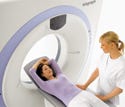Fusion Imaging Offers Breakthroughs in Clarity
Originally Published MDDI March 2006NewsTrends Erik Swain
March 1, 2006
NewsTrends
|
The Siemens Biograph system is touted to increase volumetric resolution by more than 250% over older PET/CT devices. |
Of all medical technology sectors, imaging has produced perhaps the greatest innovations in recent years. This trend appears to be continuing, thanks to a relatively new technique called fusion imaging.
Fusion imaging uses software to combine anatomical and functional images. This, according to a report by Frost & Sullivan's Technical Insights group (London), allows for a level of precision that has never before been achieved. It is providing better detection of tumors and neural disorders, among other conditions.
“Hybrid imaging modalities, such as positron emission tomography/ computed tomography (PET/CT) and single-photon-emission computed tomography/CT (SPECT/CT), are revolutionizing the field of diagnostic imaging,” says Preethi Vaidyanathan. “Several PET/CT devices with different features have already been introduced and are available commercially.” Vaidyanathan is a research analyst for Technical Insights.
|
New technology in the Siemens Biograph |
One company already marketing PET/CT devices is GE Healthcare (Waukesha, WI). Its Discovery PET/CT systems fuse two image data sets to combine the anatomical location of CT with the metabolic activity of PET. The company says the fused image provides more data in less time. The patient benefit, it says, is getting the same results from a single exam that would have taken multiple exams in the past.
Philips Medical Systems (Andover, MA) is offering its Gemini GXL PET system in conjunction with its Brilliance CT system to create a single PET/CT platform. It is touted as the only open PET/CT system. It is designed to prevent patients from feeling claustrophobic during the procedure. The design also makes it easier to perform interventional procedures if necessary.
|
To create a single PET/CT system, Philips Medical Systems offers the Brilliance CT system in conjunction with its Gemini GXL PET. |
Siemens Medical Systems (New York City) is in the market, too, with its Biograph PET/CT systems. They are touted to increase volumetric resolution by more than 250% over older PET/CT devices. Its new HI-REZ technology creates smaller voxels, permits more slices, provides better sampling, and offers finer spatial resolution.
These products represent advances, the Frost report states, because they can discern pathological from physical uptake. They can also better localize fluorodeoxyglucose uptake.
Use of SPECT/CT is more experimental at this point, with most applications currently in research facilities. It is enabling academics to investigate new tracers to target cancers, heart diseases, and bone diseases.
“By combining high-speed CT scanners with SPECT's accurate definition of disease processes, anatomical mapping and localization can be enhanced,” says Vaidyanathan. “Most significantly, CT attenuation correction greatly reduces the problems of distortion and degradation that typically occur with radionuclide-based methods.”
SPECT/CT offers better specificity than SPECT alone, resulting in better treatment for malignant lesions, according to an Italian study cited in the Frost report.Copyright ©2006 Medical Device & Diagnostic Industry
About the Author(s)
You May Also Like




